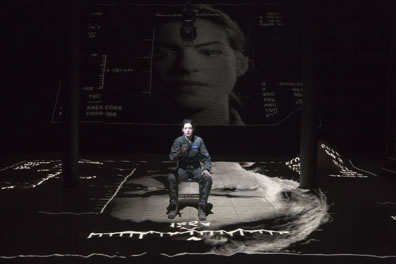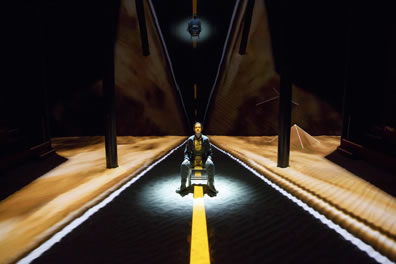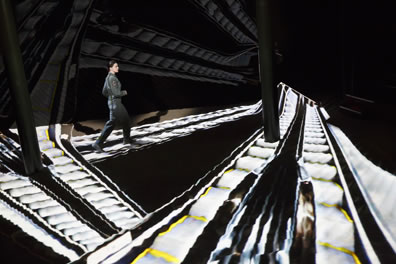Grounded
Taymor, Hathaway Team Up to Deliver
Precision Munitions on a New Warfare's Toll
By George Brant
Public Theater, Anspacher Theater, New York, New York
Saturday, May 2, 2015, D–12&14 (halfway up stage-left grandstand in three-quarter thrust theater)
Directed by Julie Taymor

Anne Hathaway as the Pilot guides her drone over a distant desert in George Brant's one-woman play Grounded at the Public Theater. Director Julie Taymor uses the white sand on the stage as a screen for projected visuals to change the Pilot's location and state of mind. Photo by Joan Marcus, the Public Theater.
For the record, we've known “princesses” who grew up to become Air Force fighter pilots. So, Anne Hathaway playing a fighter jock in George Brant's Grounded at the Public Theater is totally believable in addition to being exemplary acting. However, the true star of this one-woman play is its visionary director, Julie Taymor, and she's working with a revamped script that plays more realistically than the original iteration of this play while properly recalibrating the piece's ethical and emotional intent.
Brant's 2014 play tells the story of a hot-shot female fighter jock who gets pregnant and has to give up flying. After she has her baby and marries the father (a guy named Eric), she returns to the Air Force and is assigned to fly remotely piloted aircraft (RPA)—aka drones. Piloting missions from a trailer on Creech Air Force Base near Las Vegas, Nevada, the Pilot begins suffering post-traumatic stress disorder (PTSD). Unlike pilots actually flying in-theater, drone pilots must keep their aircraft hovering over the attacked site to assess the carnage that its missiles cause to buildings, vehicles, and people, too. Then, when the pilots' shifts end, they go straight home to their families.
This was the second production of Grounded we've seen this year: in March in Olney, Maryland, we saw a co-production by the Olney Theatre Center and Everyman Theatre starring Megan Anderson as the Pilot. My review of that production points out how Brant makes an earnest attempt to focus on two real and significant issues with drone warfare: the ethics of waging robotic warfare and the surprisingly frequent incidents of PTSD among RPA pilots. However, excessive stereotyping and some fact errors—arcane to most audiences but significant to those of us familiar with the Air Force—undermine Brant's purpose, and the play ends up derailing on a misguided plot twist making the Pilot's commander and, by implication, the Air Force itself the cause of the Pilot's downfall. Olney's program notes focused on the role of women in the military, so director Derek Goldman infused the Pilot's story with a hint of gender victimization.
Taymor not only keeps clear of gender in her version at the Public, she fixes the faults of the original script. In the production's Playbill the "special thanks" list includes this key mention: "Lt. Col. Glen F. Roberts and all the servicemen and servicewomen at Creech and Nellis Air Force Bases for their support of this production." This does not mean the play has been censored; it means the play is now absent of the little inaccuracies in everything from uniform to lingo that had undermined the original's credibility. The revised script further incorporates such facts as the Pilot moving to the Air Force Reserve instead of merely taking her own sweet time with maternity leave before returning to duty. As I said, this might be arcane to many but is noticeable to those of us in the know, and the fact that the Pilot is now in the Reserves points to the fact that Reservists are engaged in the same duties as their Active and Guard counterparts, including the RPA mission. This production also is presented in partnership with the Iraq and Afghanistan Veterans of America (www.iava.org), so getting the details right is a foundational goal with this production.
And getting the details right goes a long way toward presenting the ultimate truths of the Pilot's story: that, rather than some Air Force conspiracy or sexist dealings, her real enemy is the very nature of this new form of warfare. Far from being censored, the script now highlights how the Air Force, the U.S. military leadership, and society as a whole have never addressed the broader ethical scope of drone warfare. By getting the facts right and excising the original's ending plot twist, Taymor brings these truths home with incredible power using imagery that makes you gasp, shudder, and ultimately flinch.
One thing that hasn't changed is the Pilot's arrogance. The character is unnamed in the script—identified only as the Pilot in the cast list—and Brant's stipulations are that the actress playing her must be the proper size and physical fitness to be a fighter pilot under the Air Force's actual standards. Hathaway fits these standards and embodies the character as a woman who might have a christened name but knows herself only as the Pilot, with a capital P. This type-A++ personality attacks all of life with the confidence of a person who straddles the cockpit of a supersonic fighter jet delivering precision munitions on our nation's enemies. Brant engages in some stereotyping, especially as the Pilot cusses more than a drunken Millennial bar-hopping on a Friday night (those in the audience coming to see the sweet, princess-next-door Hathaway of Oscar-hosting reputation would be shocked). Yet, Hathaway, using a Southern accent, manages to give this character a charm and heart that results in a performance of full-throttle authenticity. Because of this, the psychological deterioration of this strong, confident servicewoman profoundly resonates.
In his script instructions, Brant notes that the Pilot is telling her story and “does not fully inhabit” the other characters in her story: “She is not an actress,” he writes. Hathaway, as a deserved Oscar-winning actress, integrates this instruction into her portrayal; this Pilot simply cannot “fully inhabit” any other character, including the other people in her life. As Eric begins worrying for the Pilot's well-being, Hathaway displays an ache in her expression that she cannot begin to fathom what's going on in his mind. She sees her daughter, Sam, as a manifestation of her own self and is confounded when Sam prefers ponies to jet fighters (“Those ****ing ponies”) and pink to sky blue. The closest Sam comes to embracing the notion of flying is playing with Pegasus, a favorite of her toy horse collection; for the Pilot that will have to do—for the time being.
The only other person in her life that the Pilot comes to understand is the Prophet, the terrorist leader she is tracking with her RPA. She subconsciously regards him as a kindred spirit and doesn't realize how much she has in common with this man until she sees him trying to protect his daughter at the very moment the Pilot unleashes her drone's precision munitions. This is the final crack in her constitution, and at this point Taymor's talents take control of this production's mission.
As I have expressed in my reviews of other Taymor works, she is a director who swings from genius (The Lion King) to self-indulgence (The Tempest) to over-inflated ego (Spider-Man). Even when her thematic visuals are nothing short of brilliant they can sometimes undermine the humanity of the work (A Midsummer Night's Dream). With Grounded, her heart and mind are completely devoted to telling the Pilot's story, both viscerally and psychologically, and though on a much smaller scale this production equals the visual and emotional power of The Lion King.


The Pilot drives through the Nevada desert between home and work (top) and rides the escalators at a Las Vegas mall. Photos by Joan Marcus, Public Theater.
We enter the three-quarter thrust theater to discover a stage covered with white sand and a single pyramid in one corner (scenic design by Riccardo Hernandez). It put in my mind that we were in a Middle Eastern desert, though the Egyptian reference seemed misplaced. Turns out that pyramid is really the one in Las Vegas, and the desert floor is not only in the Middle East and northern Africa but Nevada: it's our world and their world in one. The white sand also serves a practical purpose, as a screen for the Peter Nigrini–designed projections of the Pilot's world—a world seen through her perspective. The floor becomes the puff-clouded blue sky; it becomes the photo Eric took of her pregnant in her flight suit; it becomes the road between Creech and Vegas with AC/DC (“Thunderstruck”) blasting on her car sound system; it becomes an Escheresque network of escalators at the mall; it becomes, again, the distant desert but this time in the gray of the radar screen with green coordinates superimposed. (Also contributing to the technical marvel that is this production are the lighting design by Christopher Akerlind and the original music and soundscapes by Elliot Goldenthal.)
All of this provides the Wow! factor that is a trademark of Taymor productions (from giant animal puppets parading through the audience to Spider-Man's aerial combat with Green Lantern to Puck descending headfirst from the ceiling). However, it also is setting us up for the final images of the Pilot's final mission, not only via a projected image but also the act of Hathaway's Pilot crawling across the sand and digging up a charred, still-smoldering Pegasus.
Hathaway removes her flight suit and, clad only in her underwear, intones the play's final lines. “Know that you are not safe. Know that you can keep me here forever, you can bury me in a bunker of gray, but that does not protect you. For one day it will be your turn, your child's turn, and yea, though you mark each and every door with blood, none of the guilty will be spared. None,” and Hathaway turns to the seating stage right, where the lights come up on the audience there; “None,” she says to the now-lit center section of seating; “None,” she says turning to us on the left now bathed in light. Then she walks off stage.
It's hard to applaud after that. We do, eventually, and when the obviously emotionally spent Hathaway re-emerges for her curtain call, we give her the ovation she deserves.
And here is my ovation to Taymor. She shows utmost respect not only for the Pilot but also for the U.S. Air Force and its difficult mission. She harnesses Hathaway's acting skills and her own visionary brilliance to make us feel, not merely watch, the onslaught of PTSD. She also brings power to Grounded's theme that a government using eye-in-the-sky surveillance and destruction of its enemies can turn that technology on its own citizens. Only an ethical barrier exists to keep that from happening; but nobody, not the Air Force, not Congress, not the President, and not We the People, has strapped on the courage to define that barrier. Taymor does more than shine a light on this dilemma; she shines the light on We the People.
Eric Minton
July 7, 2015
Comment: e-mail editorial@shakespeareances.com
Start a discussion in the Bardroom



 Find additional Shakespeareances
Find additional Shakespeareances